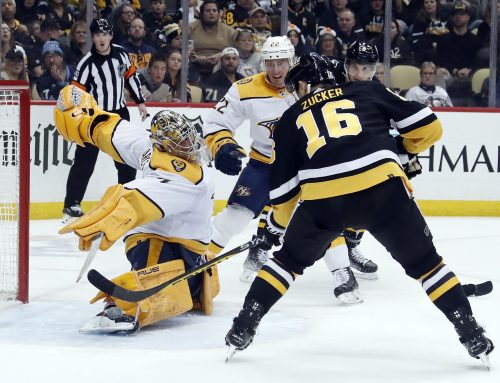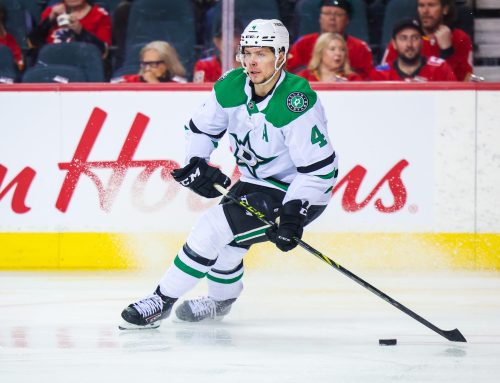
Should proven, elite (and highly paid) goaltenders be ignored in favour of cheaper options?
In fantasy leagues with a salary cap, building a winning team is more complicated than simply acquiring the best players available. Instead, the goal is to try to find the best combination of players that collectively do not exceed the cap ceiling. Managers will be faced with the challenge of deciding how much cap space to allocate to which position.
The goaltender position is the most important in hockey but also the most unpredictable. There are only two goalie positions per team (60 NHL positions in total) and only one can play at a time. In some cases a few random events can make the difference between a goalie getting 60 starts in a season and the same goalie getting as few as 20.
The unpredictability of goaltending gives the opportunity to unproven guys with cheap contracts to put up great fantasy seasons. Such examples in 2012-13 include James Reimer and Sergei Bobrovsky. Neither was seen as a slam dunk starting goalie but they certainly delivered strong numbers.
But what does this mean for the proven elite goalies that generally have the highest cap hits? Should they be ignored in favor of cheaper alternatives to give your team more cap dollars to spend elsewhere? We have to evaluate the benefits of owning these top-tier goaltenders.
First, here is a chart showing cap hit versus games played:

Out of the group of goaltenders with a cap hit above $5 million, Cam Ward and Miikka Kiprusoff missed significant time to injury and would have started the bulk of the games if healthy. Only Roberto Luongo sat out a large chunk of games as the backup. Everyone else in this group received significant ice time. These are the proven workhorses with a track record of strong production.
On the flip side, there are plenty of cheaper goalies who see plenty of time on the ice although there are plenty more in this group who barely ever get a start. However, once you get over the $2-million mark, the games played total becomes more reliable.
How does the performance of the higher-paid guys measure up against lower-paid goalies? Two charts, one showing cap hit versus points-only value in 2012-13 (win = 2 points, shutout = 3 points) and the other showing cap hit versus 2012-13 Fantrax score in a H2H roto league (24 teams with wins, saves, save percentage, GAA and shutouts):


Again, we see the same pattern. Plenty of cheaper goaltenders are among the very best in value in 2012-13 but there are tons that are barely relevant. Beyond the $2 million mark most of them are productive especially in the roto format.
While owning cheaper goalies is clearly friendlier on the budget, there is some risk involved.
Their lack of a big contract eating a big chunk of their own team's cap budget along with a lesser track record means that teams may be more willing to seek out alternatives. A prime example is Reimer, who despite an elite-level 2012-13 season (8th overall in roto league score, 10th in points-only) will now compete with the newly-acquired Jonathan Bernier for starts. Another example is Scott Clemmensen who back in 2009 started 40 games in place of an injured Martin Brodeur and picked up 25 wins. Once Brodeur returned the opportunity disappeared and Clemmensen has returned to his backup role, never winning more than 14 games in a season since.
If the cheaper, less proven goalies can maintain their high level of play over multiple seasons then they become proven commodities themselves and will be paid accordingly. Recently we have seen Bobrovsky, Tuukka Rask and Mike Smith receive big raises from their previous contracts.
Fantasy owners who were benefitting from their low cap hits now have to reserve additional space to keep their guy in the fold.
Ultimately it is up to the owner to decide how to build his roster. The reliable ace goalie that will be there for you every year is going to cost more. You pay for what you get. If you want to use cheaper alternatives to save money for the skaters, then you have to keep in mind that your goalie could be due for a big raise when his current deal is up if he is playing at an elite level. Or that goalie could face a tough stretch and have his role diminished.
If your league has farm rosters, then you should be spending a lot of time finding the next goalies to break through to the NHL. The data shows that goaltenders that are not considered elite are perfectly capable of putting top-level numbers in a given year. Having a newcomer on a cheap entry-level contract put up strong fantasy numbers is always a big boost to your squad.
So, to summarize:
Owning proven workhorse goaltender
Pros:
- Reliable year-to-year production
- Reliable number of starts barring injury
Cons:
- Costs more in cap space
- Will sometimes underwhelm in a given year compared to cheaper alternatives
Owning cheaper less proven goaltender
Pros:
- Less cap space used on goaltending position, sometimes at no cost in terms of performance
Cons:
- Opportunity could be taken away more easily forcing you to look elsewhere for help
- Could be due for a big raise soon which can cripple an unprepared fantasy owner
Which strategy do you follow?
Previously from Daoust:
Capped: The NHL’s New Pension Plan
Give Eric a follow on Twitter (@DH_EricDaoust)





 TOR
TOR S.J
S.J ANA
ANA EDM
EDM CAR
CAR DET
DET CGY
CGY VAN
VAN MIN
MIN
